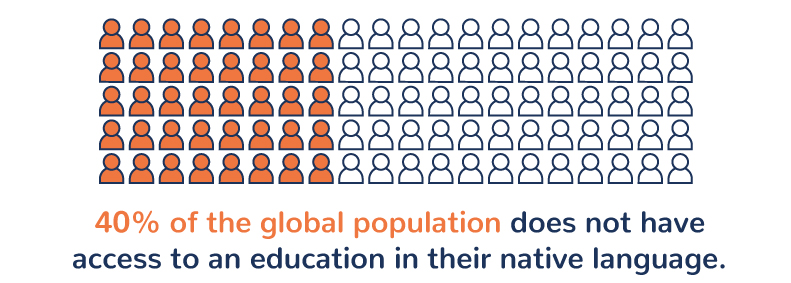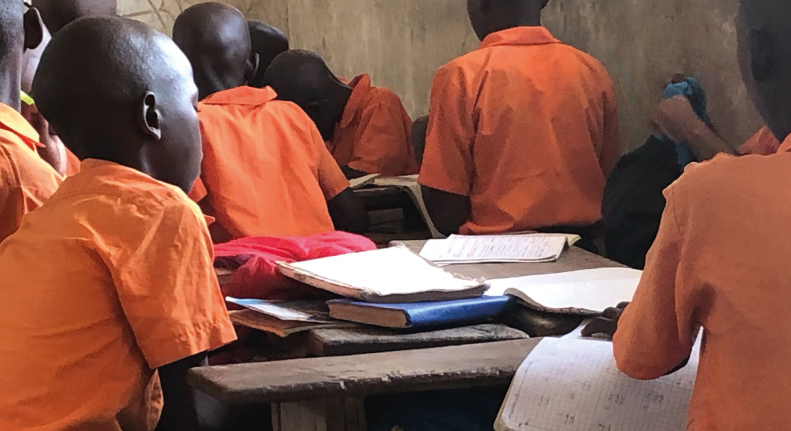Many commentators have highlighted the rapidly growing phenomenon of English Medium Instruction (EMI) – in other words, the use of the English language (L2) to teach academic subjects in countries or jurisdictions where the first language (L1) of the majority of the population is not English. Driven largely by parental demand, over 8,000 international schools now teach 4.5 million mostly L1 students worldwide, usually in English, with these numbers expected to double over the next 10 years. On a different scale altogether, in many countries, especially those with a colonial past, local private and state schools have either been employing EMI for many years or have more recently adopted EMI in response to the pressure of demand for students to develop competence in English.

It’s estimated that 40% of the global population does not have access to an education in their native language meaning that we are talking of literally hundreds of millions of students. Although some other dominant languages are involved, most of these students are being offered EMI.

Yet study after study has questioned why EMI is pursued when educational outcomes in so many non-English speaking countries are so poor. In 2016, UNESCO asked “If you don’t understand, how can you learn?” and recommended that at least six years of L1 mother tongue education should be provided in ethnically diverse communities to ensure students do not fall behind.
In a study of EMI in 55 countries in 2013-14, Oxford University’s Department of Education concluded that in many of them, the educational infrastructure does not support quality EMI provision because of:
- the shortage of linguistically qualified teachers
- lack of stated expectations of English language proficiency
- few organisational or pedagogical guidelines to support effective EMI teaching and learning
- provision of little or no EMI content in initial teacher education programmes and continuing professional development courses
The British Council, Education Development Trust and the Open University collaborated in a 2017 study of multilingual classrooms, specifically in Ghana and India, with a view to understanding the opportunities and challenges for EMI in low and middle income contexts. In both locations, the study made the link between low levels of achievement and progression resulting from the need for children to learn the language at the same time as learning the curriculum.
The linguistic challenge of maths
This challenge is polarised in the learning of maths in particular, with specialist vocabulary and syntax adding a layer of complexity. Furthermore in Pisa’s 2015 findings, not a single participating country worldwide, developed or less developed, had a higher proportion of 15 year old students reaching the lowest proficiency in maths than in reading, with proportions below the lowest level in proficiency significantly larger in less developed countries.
The importance of the language of instruction for maths achievement has been shown in a number of studies. In Ethiopia, where different regions switch from mother tongue to English at different stages (between Grades 0–7), a major study showed that the longer the delay in switching from mother tongue to English, the better the performance in maths. A study of the role of language in the teaching and learning of early grade maths in Kenya, Malawi and South Africa between 2006 and 2016 (in all of these countries, maths is taught primarily in English) concluded that none of the benefits of bilingual education were being achieved.
The way forward for bilingual maths learning
To reconcile the demand for EMI and the known benefits of bilingualism with the poor educational outcomes being achieved, it is necessary to understand that total immersion in English too early in an L1 child’s education is not the answer; research would suggest that maths should be taught and learned in a child’s mother tongue for the first 6 or 7 years of schooling, and until the child has developed reasonable competence in English. Furthermore, adherence to the other principles of Professor Jim Cummins’ model of additive bilingualism will be much more likely to lead to improved educational outcomes than a rigid EMI approach.
These insights led us at Whizz Education to the development of bilingual versions of Maths-Whizz where each animation and each test are available to the individual student in both English and the student’s dominant local language.
Live learning data allows us to track and evaluate the contribution bilingual learning can make to raising standards in maths in our international markets; early indications are positive in Project iMlango, operating across rural counties of Kenya, where 25% of the youngest age groups of students chose to complete Maths-Whizz animated exercises and tests in Kiswahili instead of English. More significantly, the students choosing Kiswahili versions improved their average lesson pass rate by 4% yet reduced the time they took to complete the lessons by 11%, particularly significant in an educational environment where computer time available for students is so limited.

The decision of whether to select Kiswahili or English as the language of instruction lies with the students and their teachers, and this has led to some counterintuitive results. For example, a higher number of students complete a Kiswahili animated exercise, then undertake the related test in English than take a test in Kiswahili after an English animated exercise. Furthermore, considerably more students who fail an exercise in Kiswahili then switch to an exercise in English than fail an exercise in English and then switch to an exercise in Kiswahili.
By contrast, Professor Cummins would argue that students weak in English should initially undertake both exercises and tests in their L1, progress next to choosing “context embedded” animated lessons in English while continuing to complete the related “context reduced” test in their native language, and only attempt tests in English when their competence in L2 has reached a high level, probably after Grade 6. While young students are in the Tutor mode of Maths-Whizz, they should attempt lessons in L1 only and use Replay to see whether they are able to complete the same animated exercises in English.
In this writer’s opinion, we need to provide recommendations like these to our students and teachers as to how to make best use of the powerful language of instruction option we have given them – not just in Kenya with Kiswahili but also in Thailand with the Thai language option we have provided and in Mexico with Spanish.
Global economic prosperity will continue to benefit from more young people developing second and third language skills. Research has shown that learners should develop their L1 first, learn cognitively demanding subjects like maths initially in L1, and then progressively develop their competence in an L2 like English, including a transition into the study of maths in L2, when they will cross a threshold into cognitive advantage over their monolingual peers. Bilingual Maths-Whizz, correctly implemented, can be a major contributor to these higher order educational outcomes.
